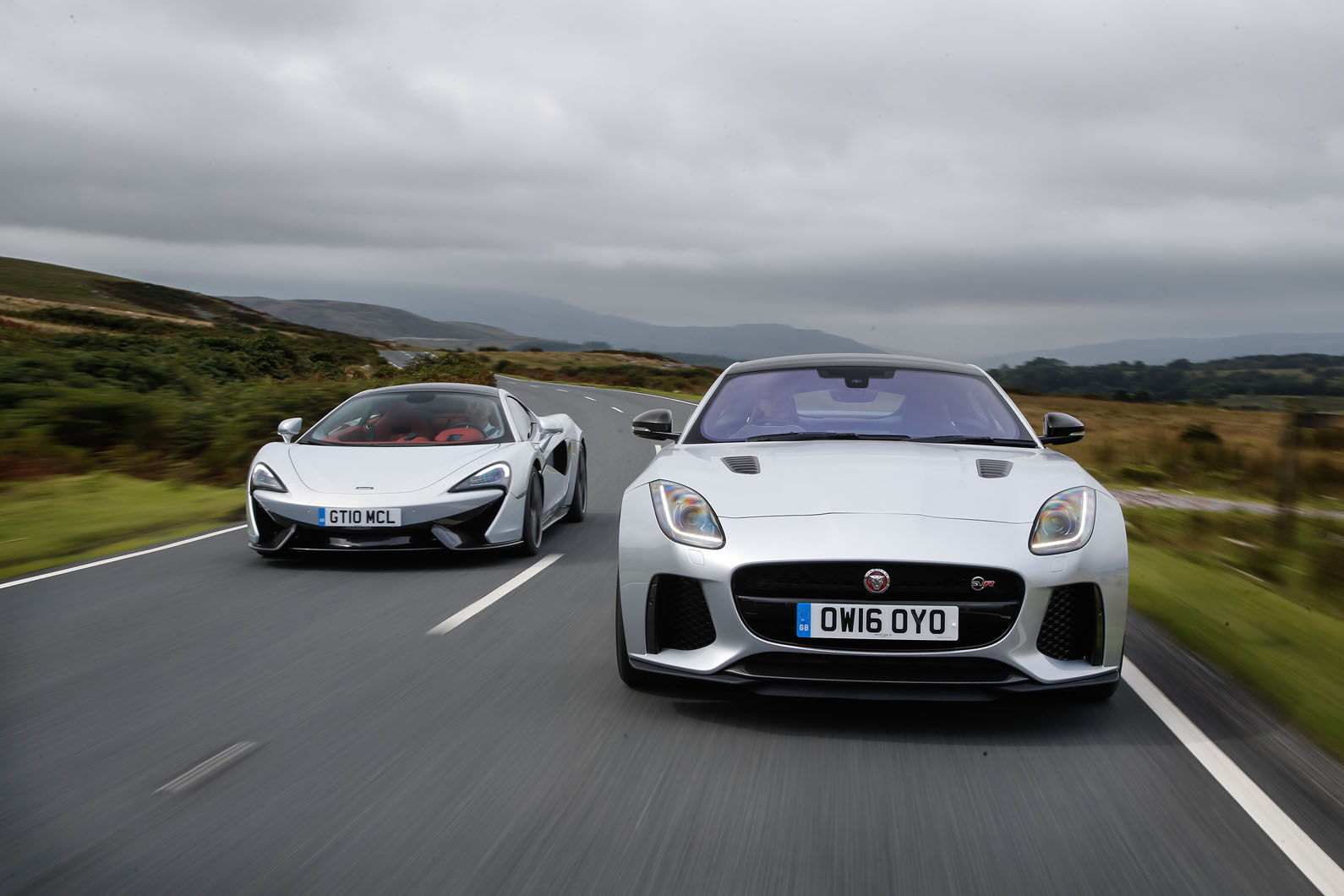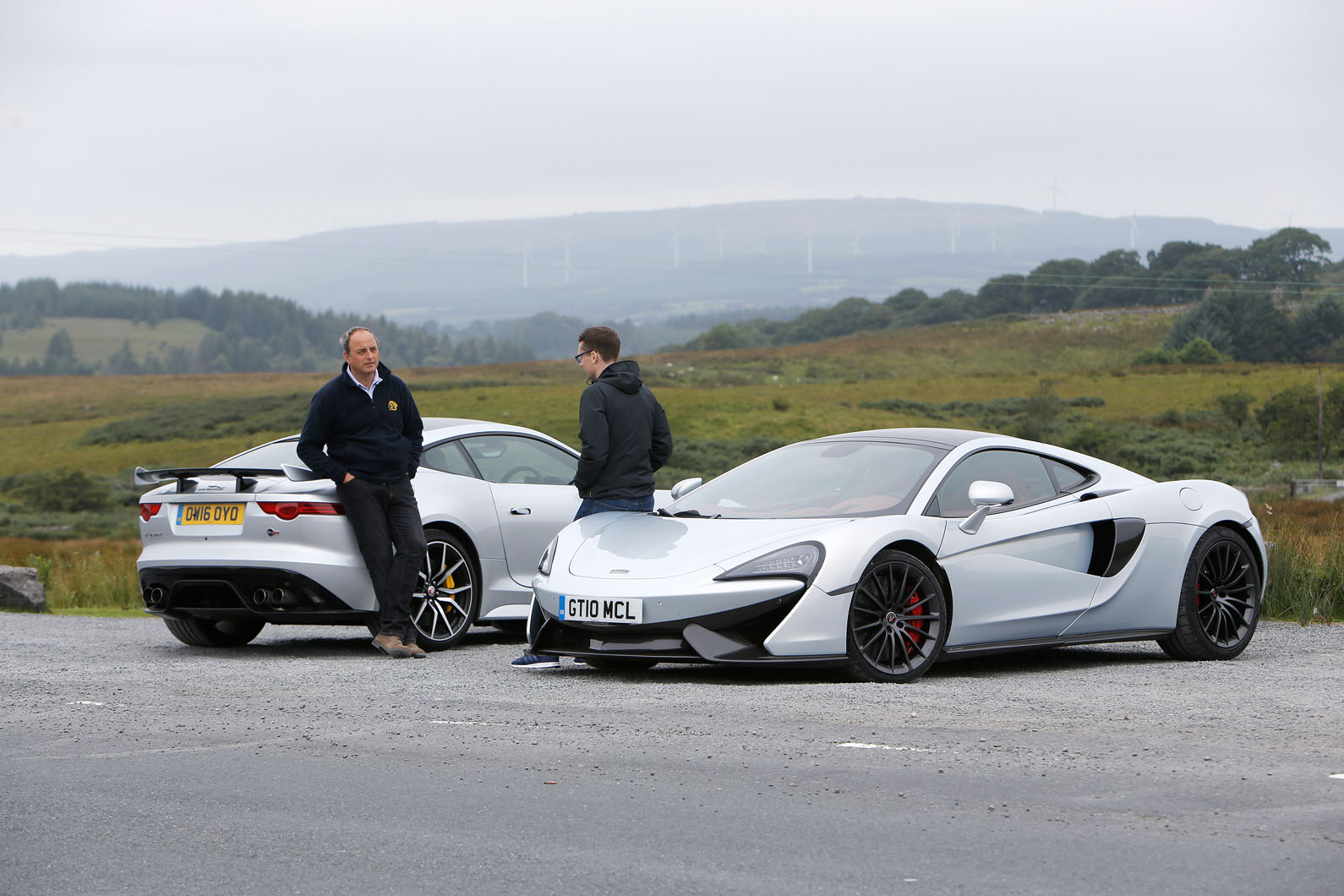The McLaren 570GT takes on the Jaguar F-Type SVR in our comparison of some of the greatest British GTs.
These are the cars we do best.
Over the years, Britain has been responsible for a few decent family hatches, probably more than our fair share of excellent off-roaders, a strong smattering of low-volume, stripped-out sports cars, more world-class executive saloons than you might think and even the odd all-out supercar. But from the moment that Sunbeams and Vauxhalls really announced Britain’s presence on the global automotive stage after the Great War, it's been fast, long-legged, sporting grand tourers at which we have excelled. Think of all those thundering Bentleys, dashing Aston Martins and even some of the swoopier Rolls-Royces: these are the cars that defined the concept of the gentleman’s carriage - if such a pejorative is even permissible these days.
Then there were the Jaguars. Always the Jags. From the XK to the E-Type, the Jaguar XJS to the Jaguar F-Type, in terms of their popularity, they have represented the apotheosis of this breed: fast, curvaceous, raffish and with just a faint whiff of cad left hanging in their exhaust smoke, Jaguar’s sporting coupés are the very embodiment of the great British GT. And none more so than the F-Type SVR.
You sense that the SVR is a car Jaguar would have liked to make many moons ago. But the company was too small, its products too patchy and its image too weak to sustain a sports car costing six figures. Indeed, even when the F-Type was being conceived, there was no such model in the product plan. But that was years ago and now Jaguar feels ready to sweat the brand in the same way that Jaguar Land Rover has done so successfully with Range Rover in recent times. So forget what you might read elsewhere; the SVR is no kind of revolution at all but, in theory at least, a next step on an already well-travelled road. The only question is whether it’s in the right direction.
Who’d have expected it would be McLaren that would help us figure that out? McLaren: a company known for supercars, hypercars, Formula 1 cars, Can-Am cars and absolutely not long-distance touring cars. If the SVR comes closest to fitting our idealised image of what a Jaguar should be, the 570GT is the least McLaren-like McLaren there has been.

Here is a McLaren whose prime differentiators from its stablemates are ride comfort and luggage space. At its launch, a company sharing a name and premises with an F1 team touting 182 wins to its credit decided to go in hard on the fact that the 570GT has more luggage space than a Ford Focus. I guess that’s sweating the brand, too, albeit in a rather different way.
Seeing the two cars there, parked on a Welsh hillside, what they share (their Britishness, their forced-induction V8 engines and similar power outputs) seems as nothing compared with what sets them apart. I celebrate that. Here are two cars trying to do broadly similar jobs, albeit at somewhat dissimilar price points, coming at it from utterly different directions. One places its engine behind the driver, the other ahead. One directs its power only rearward, the other in all four directions. One uses exhaust-driven turbochargers, the other an engine-driven supercharger. One has a structure of carbonfibre, the other of aluminium. The starkest contrast,though, is that one is a traditional GT with aspirations of cutting it as a supercar and the other comes from true supercar stock and is trying to tease that into GT form.
I drove the McLaren first because I’d driven it before and wished to be reminded of how high the bar for the SVR has been set. As any drive in any McLaren tends to be these days, it was a breathtaking experience. I’d driven a 570GT only a few weeks ago, but that’s all the time you need to forget just how damned fast this car is and how effortlessly it deploys its potential via the ever-changing, always compromised medium of the British public road. A lot of the time, you actually steer clear of the band between 5000rpm and 8000rpm when it goes completely nuts, because on tortuous roads, it’s almost too much – not for the car but its driver. Through every instant upshift as you’re thrown across the landscape, you must remind yourself: this is the slow one, the point at which McLaren street machine performance begins. With the little V8 yelling at you as someone apparently grabs each end of the horizon and yanks it towards your face, it seems barely conceivable.

Yet it’s even better at the sections between each straight. It is true that the softening of the 570GT’s spring rates has had a detrimental effect on primary ride control and, yes, the 570S I drove not long ago on this exact road would have been even better at maintaining its ride height and inspiring confidence in its driver, but all things are relative. Compared with anything else this money can buy, the 570GT is astounding. It’s better than that, though. This is not a driving experience merely to inspire awe and admiration but, far more important than that, it is also bloody good fun. That slightly aloof, antiseptic air of the early 12Cs has been exorcised, and nor does the car appear to suffer as a driving machine for not having the clever interlinked suspension of more expensive McLarens. Its ride quality may be more good than great, but I’d say its steering feel is even better. I’ll tell you this: drive one of these hard just once on a decent road and you will never, ever forget it.
Exiting the McLaren and approaching the Jaguar, I did momentarily wonder what we were doing here. This was never meant to be a back-to-back test of directly comparable cars, but more a celebration of this country’s creative ability to arrive at solutions to the same challenge from such different ways. Even so, the svelte shape of the 570GT did rather make the SVR, with its tacked-on rear wing, appear to be exactly what it is: a car that was never originally intended. And after a performance – let’s call it an exhibition – such as that proffered by the McLaren, what could the Jaguar, with its nose-heavy layout, automatic gearbox and a quarter of a tonne of extra mass, possibly have to add?
More than I imagined. There are few cars that would look less than completely stupid going over the same ground just covered by a 570GT, but the SVR is one of them. Whereas in the McLaren, it is the performance that hits you first, followed by how deftly it is managed by the rest of the car, the experience is the other way around in the SVR.
In a straight line, the SVR is not nearly as quick. In fact, it feels further behind than you’d expect, based on their relative power-to-weight ratios. It’s extremely rapid yet never quite unhinged in the way the McLaren can appear on even quite short stretches of open road. But here’s the interesting thing: pure pace is not what this car is about. Indeed, the fact that it’s faster than an F-Type R (because it is not just more powerful but lighter, too) is almost an irrelevance. What matters is that it is so much better to drive.

For all its steroidal bodily addenda, the SVR is rather subtle in what it does best. I noticed the damping first of all. It doesn’t try to resurface the road, as does the McLaren.It breathes with it instead, allowing a little vertical motion but controlling it so deftly that no hint of instability is allowed. It fits the character of the car perfectly. Next, I found myself marvelling at how the steering retained all the incisiveness of the F-Type R’s while losing its slightly aggressive edge. Then there was the car’s balance: no car on sale has been helped more by the addition of four-wheel drive than the F-Type, and the SVR takes that good work and reimagines it on another level.
Of course, the engine is wonderful and its voice when spat out through its titanium and Inconel exhausts on the overrun is the stuff of schoolkid dreams. Its mighty mid-range punch also fits perfectly the kind of car the SVR is and the gearbox is as fast, smooth and intuitive as you might reasonably expect an auto to be. But for all the speed and thunder and contrary to every appearance, the SVR is the first high-performance Jaguar since the XJ220 that casts its powertrain in a supporting role to its chassis. Until I drove it, I’d never have believed it to be possible.
As long-distance cruising machines, the SVR’s and 570GT’s propositions are similarly different from each other and delightfully unpredictable. Who’d have thought the McLaren would offer the better ride comfort and carrying capacity? But it is the Jaguar that’s quieter and has better seats. Both have pretty inadequate navigation systems and storage space on board.
You, of course, need a winner, and I’m going to give it to the McLaren, despite there being more than a Porsche 718 Cayman between their prices. The 570, in both S and GT forms, is one of the most remarkable cars of its kind produced by any car manufacturer in the near 30 years I’ve been reviewing them and, good though the SVR is, it ain’t that good. But that’s not what’s important here.
So what really matters? It matters that when it comes to ultra-high performance grand touring cars, Britain remains up there with the best. It matters that this test adds to the narrative that says McLaren Automotive, despite being launched just five years ago with a flawed and unfinished product, is now one of the most coveted car brands on earth.
Yet we’ve heard all that before. To me, what matters most here is that in the SVR, Jaguar has found a new direction: not just faster, but better. More considered, capable, subtle and rewarding, this is the Jaguar sports coupé I’ve been waiting for. It makes me excited not just for what JLR’s SVO skunk works might do next but also to learn how such good work might filter down to influence more affordable Jaguars. After all, if Jaguar can do this well with a car that was never in the product plan, just imagine what it might do with one it had intended from the start.











































Join the debate
Add your comment
I would love to see what Jag
A jet and a propeller
Prices